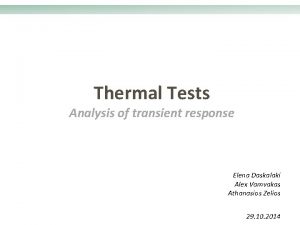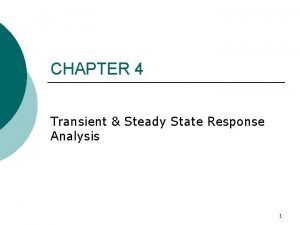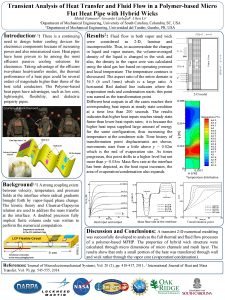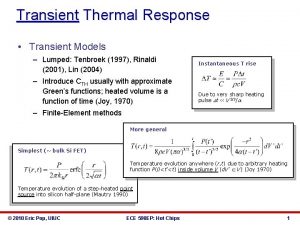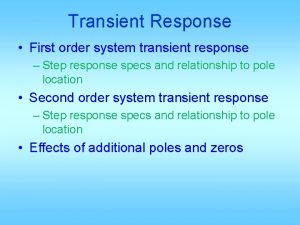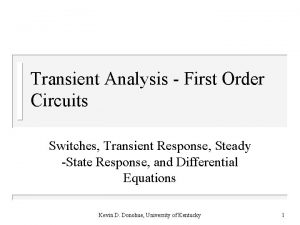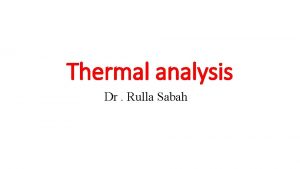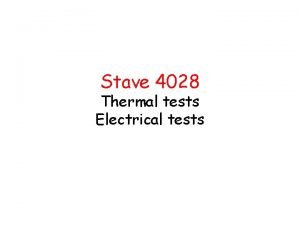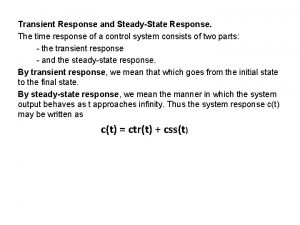Thermal Tests Analysis of transient response Elena Daskalaki











- Slides: 11

Thermal Tests Analysis of transient response Elena Daskalaki Alex Vamvakas Athanasios Zelios 29. 10. 2014

Aim To find the time constant of each component as a function of: • • Power applied Water flow Component geometry Ambient conditions 2

Theory 62. 3% of ΔΤ ΔΤ τ 3

Tests plan P 1 F 1 T 1 P 1 F 2 T 1 P 1 F 3 T 1 P 2 F 1 T 1 P 2 F 2 T 1 P 2 F 3 T 1 P 3 F 1 T 1 P 3 F 2 T 1 P 3 F 3 T 1 P 1 F 1 T 2 P 1 F 2 T 2 P 1 F 3 T 2 P 2 F 1 T 2 P 2 F 2 T 2 P 2 F 3 T 2 P 3 F 1 T 2 P 3 F 2 T 2 P 3 F 3 T 2 P 1 F 1 T 3 P 1 F 2 T 3 P 1 F 3 T 3 P 2 F 1 T 3 P 2 F 2 T 3 P 2 F 3 T 3 P 3 F 1 T 3 P 3 F 2 T 3 P 3 F 3 T 3 4

Time constants SAS Tamb= 20 o. C Tamb= 30 o. C 5

Time constants PETS Tamb= 20 o. C Tamb= 30 o. C 6

Theoretical analysis pper To co To water To ai r geometry water flow 7

Theoretical analysis Comparison of SAS temperature profile: Experimental vs theoretical data 8

Conclusions • Time constant of SAS ranges between 4 -11 minutes. • Time constant of PETS ranges between 15 -30 minutes. • In both cases, the time constant depends highly on water flow. • The time constant does not depend on applied power and ambient temperature. • Theoretical analysis matches very well with experimental data. This allows us to use this model for the prediction of the transient and steady-state response of the components. • The time constant of the components can be controlled as desired through the regulation of the water flow. 9

Comments • The PETS cannot be heated independently of the DBQs • DBQs are very slow compared to PETS and SAS (~ 3 hours to reach steady-state) • PETS are strongly coupled to DBQs because of o Their proximity o The heating of the cooling channel which connects the two PETS units • The conclusions reached from the analysis of PETS cannot be as accurate as those of the SAS. 10

Next steps • Improvement of DB heating system for more accurate analysis How accurate do we want to be? • Repetition of representative cases with both temperature and alignment measurement • Analysis of failure modes 11
 Time constant
Time constant Steady state response
Steady state response Transient response in vlsi
Transient response in vlsi Rw + vo c inverter transient response vod inverte...
Rw + vo c inverter transient response vod inverte... Dynamic response
Dynamic response Ace different tests iq tests but
Ace different tests iq tests but Saidah examination
Saidah examination Dc transient analysis
Dc transient analysis Transient analysis thermodynamics
Transient analysis thermodynamics Thermal energy section 3 using thermal energy
Thermal energy section 3 using thermal energy Thermal transfer vs direct thermal printing
Thermal transfer vs direct thermal printing Natural response and forced response
Natural response and forced response
